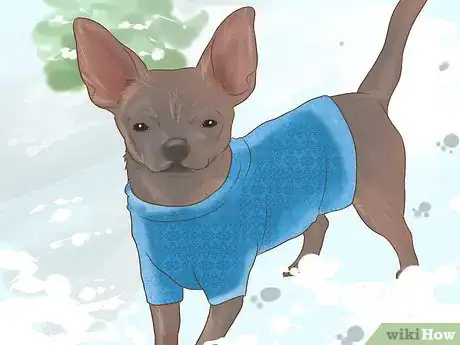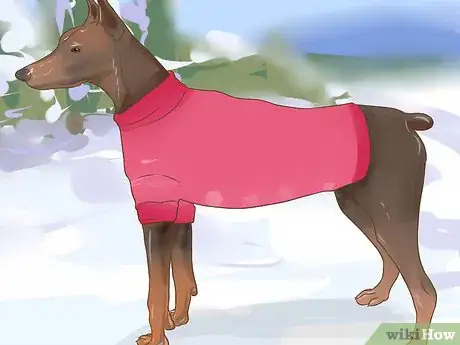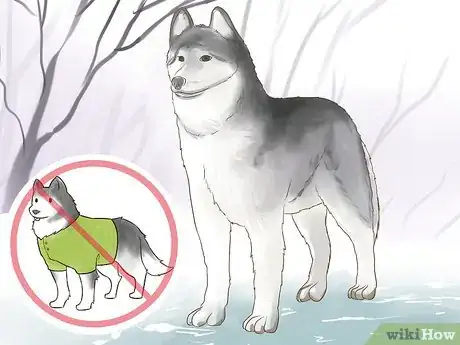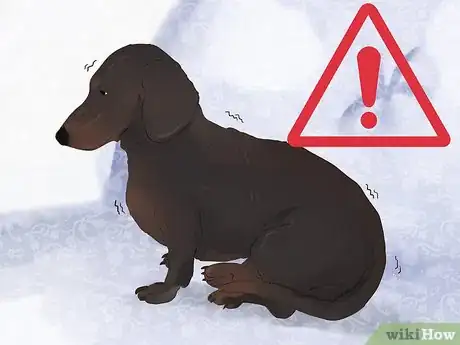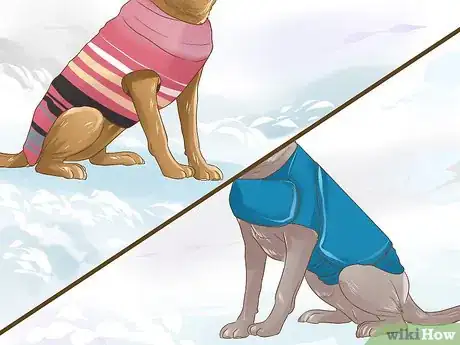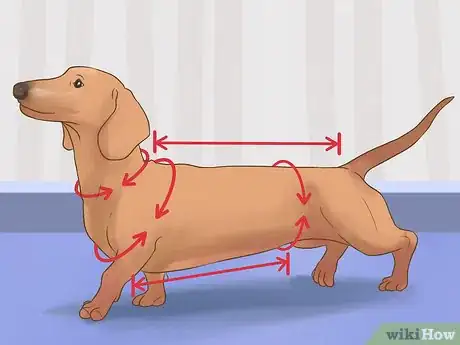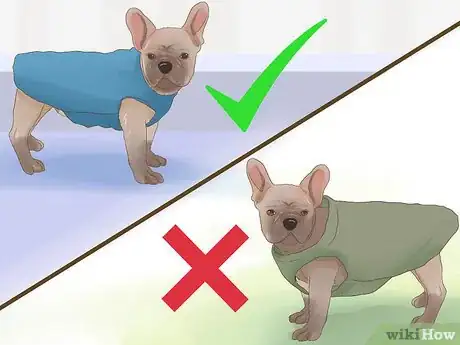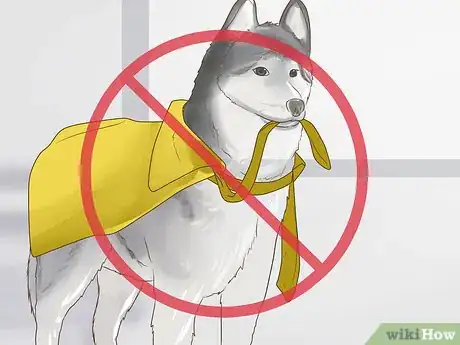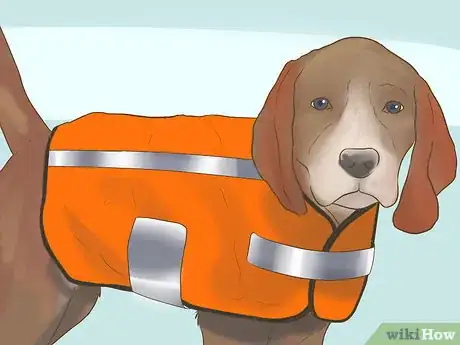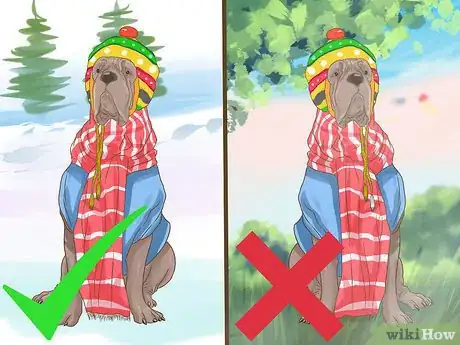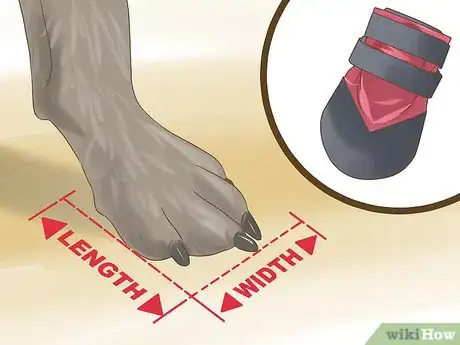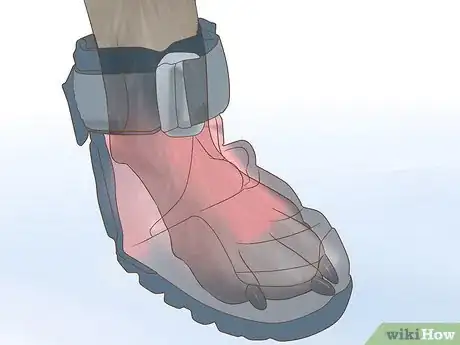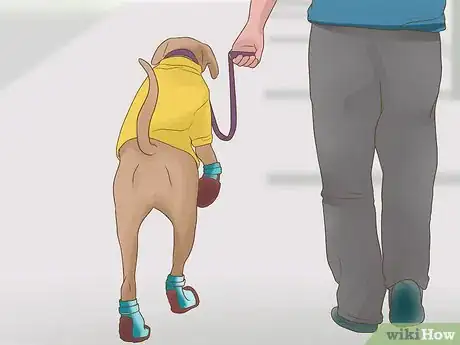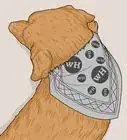This article was co-authored by Amanda Marshall-Polimeni. Amanda Marshall-Polimeni is a Dog Behavior Consultant and the Owner/Founder of FurryTales in New Jersey. With a deep understanding of behavioral learning theories and a passion for the physical and psychological well-being of animals, Amanda specializes in using non-coercive, reinforcement-based approaches to generate desired behaviors. Amanda holds a BASc in Applied Psychology from NYU and is a Certified Professional Dog Trainer - Knowledge Assessed (CPDT-KA) and Certified Behavior Consultant Canine (CBCC-KA). She has also completed a Master’s Course in Aggressive Dog Training. Her initiative and dedication to quality, comprehensive animal care at FurryTales led to her recognition by Grow by Acorns + CNBC.
There are 7 references cited in this article, which can be found at the bottom of the page.
This article has been viewed 31,440 times.
Many dogs can adjust naturally to winter weather. However, certain types of dogs, like toy and short-haired breeds, are more affected by the cold, and extreme weather conditions can endanger any animal. Jackets, sweaters, booties, and other outdoor gear can go a long way towards keeping your pet healthy and safe. Protect your canine companion during the coldest months by learning when and how to dress them up for winter conditions.
Steps
Knowing When to Dress Up Your Dog for Winter Weather
-
1
-
2Dress up lean, short-haired dogs. If your dog has a thin coat and/or low body fat, they have less natural protection from the cold. Short-haired breeds, like Boxers, Greyhounds, or Dobermans, should have extra protection, like sweaters or coats, when they're facing below-freezing temperatures to help them retain their body heat.[3]
- This also applies to dogs, such as Poodles, that are highly groomed in a manner that keeps their fur very short.
Advertisement -
3Suit up older dogs. If you have a senior dog with a compromised immune system, it's a good idea to give them the extra protection of a sweater or jacket when facing cold weather.[4]
-
4Let the natural coats of hearty breeds protect them. Some types of dogs are specifically bred to withstand winter conditions. These large, hearty breeds, like Newfoundlands, Saint Bernards, and Siberian Huskies, come with thick, double coats of fur. They typically don't require additional gear to help them with cold weather.[5]
- Dressing up dogs with dense fur in outerwear can even be detrimental, leading to overheating.
-
5Pay attention to your dog's signals. Regardless of your dog's size, fur, breed, or condition, be sure to take cues from their behavior to see if you should be dressing them for the cold. If they show signs of being chilled, it's always a good idea to bundle them up before you take them any further.[6] [7]
- If you notice that they're shivering for an extended period of time, getting sluggish, coming to a complete stop, and/or trying to keep one or more paws off the ground when they walk, it's likely that your dog is being negatively affected by the cold.
Picking the Right Outwear
-
1Decide between a sweater and jacket. If you're simply trying to protect your dog from cold temperatures or taking them out for short outdoor sessions of less than a half hour, a sweater is probably sufficient. If you're taking your dog out into snowy conditions, wind, precipitation, or extreme cold (like below-zero F or below -15 degrees C), then it's better to dress them in a waterproof coat since they offer more substantial protection.[8]
- If it's at all wet or snowy outside, it's best to go for a waterproof jacket. Wet sweaters can make your dog colder instead of keeping them warm.
-
2Pick garments made from sturdy, convenient material. If your primary objective is trying to protect your dog from the cold rather than making a fashion statement, you should go for outdoor apparel that's constructed from durable and breathable fabrics, like nylon, a wool blend, or fleece. Make sure that the gear is also machine washable for easy cleaning.[9]
- If you're going for a coat, select one that has a waterproof or water-resistant exterior so that it can withstand the elements.
-
3Get the sizing right. Each product and brand will have different sizing guidelines. Whether you're shopping online or at a pet store, be sure to check the specific sizing charts associated with a particular product before purchasing it.[10]
- Prepare yourself to find the right size for your dog by taking some key measurements. Use a tape measure to take the circumferences of your dog's neck, chest (around their biggest rib), and waist. You should also measure the distances between the base of their neck and their waist, and between the base of their neck and the base of their tail.
- Some garments may have sizing charts that are determined by your dog's weight.
-
4Make sure their gear fits well. Sweaters and coats should fit snugly but comfortably. If they're too big, they'll drag and compromise the warmth of the garment. If they're too small, they'll constrict your dog's blood flow, irritate their skin, and/or restrict their movement.[11]
- Dog apparel should be easy to take on and off. Once it's on, you should allow your dog to move around in it to see if their range of motion or natural gait is at all affected.
- You should also check that you can fit two fingers (one finger for small dogs) under the neckline or any other openings to be sure that they won't chafe your dog's skin.
-
5Avoid designs with potentially dangerous accessories. Many dogs are not in love with wearing clothing, and may try to remove it. If your dog is wary of clothing or prone to chewing, avoid getting garments that have decorations or accessories, like pom-poms or ribbons that could easily be clawed or chewed off. You don't want your pooch eating their apparel![12]
-
6Get lights and/or reflective gear. The dark sets in early during the winter months. Ensure that you and your dog can be seen by wearing lights and/or dressing them up in reflective or bright clothing.[13]
- Consider attaching clip-on lights to your dog's collar or getting a light-up collar so that you don't lose your pet and so that they're obviously visible to other people, pets, and motorists.
- You could also go for a coat that has reflective strips or material as part of the design.
-
7Reserve additional accessories for extreme conditions. You may want to put your dog in a hat and scarf because it's adorable, but these accessories are not necessary winter gear for canines in most conditions. If you are preparing your dog for prolonged exposure to temperatures that are well below freezing, gale-force winds, or an active snowstorm, then adding a hat to their jacket would be a good idea.[14]
- Keep in mind that the wisest thing to do in extreme winter conditions is to keep yourself and your dog inside.
- If you do need to venture out, the most practical hats for dogs will be bands that tuck under their chins and wrap over their ears.
- Neck warmers designed for humans also make good hats for dogs.
Fitting Your Dog with Booties
-
1Get booties for your dog. If you live in a cold climate with lengthy winters or your dog's feet are especially sensitive to salt or cold, it's a good idea to get your pooch cloth or rubber booties to protect their paws.[15]
- Besides keeping your dog's feet warm, booties can also help shield your pet from ice, snow, salt, and grit. Being exposed to these winter hazards can injure your dog's feet or leave their paws painfully dry and/or cracked.
- Pick a material that's sturdy enough to offer protection and withstand harsh conditions while being flexible enough to comfortably adjust to the shape of your pet's feet.
- They should also have waterproof or water-resistant exterior to keep your dog's paws dry.
- Consider getting boots with traction or grips on the bottom to help your pooch navigate through snow and ice.
- Since these are specialty items, pet stores will not always stock them, and ordering them online may be easier.
-
2Make sure to get the right size. Before you buy a set of booties, check the brands' specific sizing chart to get the right fit. There are no standardized shoe sizes for canines, and booties come in a wide array of designs. Thus, it's critical to refer to the particular sizing and measurement guidelines used by the brand of booties you are ordering.[16]
- Getting the right size will require you to take measurements of your pet using either a scale or a tape measure. Some dog shoe companies use sizing charts that go by weight. Others will ask you to measure the distance between a dog's heel and toenail.
-
3Check that they have the right fit. Your dog's booties should slip on and off easily and have an adjustable strap to keep them snugly in place around your dog's ankles. They should fit securely around the ankle but leave plenty of room for your dog's paws to breathe since they regulate heat through the pads of their feet.[17]
- Be sure that your dog's booties are tight enough to stay on without being uncomfortable. Check to see that the ankle straps aren't rubbing or chafing your dog's skin or fur.
- Also check that the booties aren't affecting your dog's natural gait. While they may walk differently in their shoes at first, be wary if your dog does not adjust back to their normal stride over time. This can indicate that the shoes are cramping their feet or placing pressure on their claws.
-
4Help your dog adjust to booties. Wearing shoes does not feel natural to canines, so it may take them a while to get the hang of it. Make the period of adjustment as short and pleasant as possible by rewarding them with a treat after you put on each bootie.[18]
- Giving your pooch treats along with their booties will help them develop positive associations with wearing shoes. Taking them out for a walk immediately after you put them on will also boost their positive associations with booties.
- It's also a good idea to keep your dog under control on a leash initially until they've adapted to walking in booties. If you notice that the booties are slipping off, stop and adjust the Velcro straps until they fit tightly enough to stay on.
Expert Q&A
-
QuestionDo dogs need clothes in the snow?
 Amanda Marshall-PolimeniAmanda Marshall-Polimeni is a Dog Behavior Consultant and the Owner/Founder of FurryTales in New Jersey. With a deep understanding of behavioral learning theories and a passion for the physical and psychological well-being of animals, Amanda specializes in using non-coercive, reinforcement-based approaches to generate desired behaviors. Amanda holds a BASc in Applied Psychology from NYU and is a Certified Professional Dog Trainer - Knowledge Assessed (CPDT-KA) and Certified Behavior Consultant Canine (CBCC-KA). She has also completed a Master’s Course in Aggressive Dog Training. Her initiative and dedication to quality, comprehensive animal care at FurryTales led to her recognition by Grow by Acorns + CNBC.
Amanda Marshall-PolimeniAmanda Marshall-Polimeni is a Dog Behavior Consultant and the Owner/Founder of FurryTales in New Jersey. With a deep understanding of behavioral learning theories and a passion for the physical and psychological well-being of animals, Amanda specializes in using non-coercive, reinforcement-based approaches to generate desired behaviors. Amanda holds a BASc in Applied Psychology from NYU and is a Certified Professional Dog Trainer - Knowledge Assessed (CPDT-KA) and Certified Behavior Consultant Canine (CBCC-KA). She has also completed a Master’s Course in Aggressive Dog Training. Her initiative and dedication to quality, comprehensive animal care at FurryTales led to her recognition by Grow by Acorns + CNBC.
Dog Behavior Consultant Generally, if the temperatures are below 40°F and your dog is shivering, you should put it in a jacket or sweater.
Generally, if the temperatures are below 40°F and your dog is shivering, you should put it in a jacket or sweater. -
QuestionDo dogs get cold in the snow?
 Amanda Marshall-PolimeniAmanda Marshall-Polimeni is a Dog Behavior Consultant and the Owner/Founder of FurryTales in New Jersey. With a deep understanding of behavioral learning theories and a passion for the physical and psychological well-being of animals, Amanda specializes in using non-coercive, reinforcement-based approaches to generate desired behaviors. Amanda holds a BASc in Applied Psychology from NYU and is a Certified Professional Dog Trainer - Knowledge Assessed (CPDT-KA) and Certified Behavior Consultant Canine (CBCC-KA). She has also completed a Master’s Course in Aggressive Dog Training. Her initiative and dedication to quality, comprehensive animal care at FurryTales led to her recognition by Grow by Acorns + CNBC.
Amanda Marshall-PolimeniAmanda Marshall-Polimeni is a Dog Behavior Consultant and the Owner/Founder of FurryTales in New Jersey. With a deep understanding of behavioral learning theories and a passion for the physical and psychological well-being of animals, Amanda specializes in using non-coercive, reinforcement-based approaches to generate desired behaviors. Amanda holds a BASc in Applied Psychology from NYU and is a Certified Professional Dog Trainer - Knowledge Assessed (CPDT-KA) and Certified Behavior Consultant Canine (CBCC-KA). She has also completed a Master’s Course in Aggressive Dog Training. Her initiative and dedication to quality, comprehensive animal care at FurryTales led to her recognition by Grow by Acorns + CNBC.
Dog Behavior Consultant It depends on their breed and size. If the dog is larger and more accustomed to winter weather, than they may be fine outside.
It depends on their breed and size. If the dog is larger and more accustomed to winter weather, than they may be fine outside.
Warnings
- Never leave your dog unattended in a coat because they may get caught on something.⧼thumbs_response⧽
- Even the heartiest dogs face health risks, like frostbite and hypothermia, from prolonged exposure to below-freezing temperatures. Never leave your dog outside in the cold for long periods of time, no matter how they're dressed.⧼thumbs_response⧽
References
- ↑ Amanda Marshall-Polimeni. Dog Behavior Consultant. Expert Interview. 25 February 2021
- ↑ https://www.bluecross.org.uk/pet-advice/pet-winter-survival-guide
- ↑ https://www.bluecross.org.uk/pet-advice/pet-winter-survival-guide
- ↑ http://www.petmd.com/dog/seasonal/evr_dg_sweaters_for_dogs
- ↑ http://www.petmd.com/dog/seasonal/evr_dg_sweaters_for_dogs
- ↑ Amanda Marshall-Polimeni. Dog Behavior Consultant. Expert Interview. 25 February 2021
- ↑ http://www.mnn.com/family/pets/stories/does-your-dog-need-winter-clothes
- ↑ http://www.petmd.com/dog/seasonal/evr_dg_sweaters_for_dogs
- ↑ http://www.caninejournal.com/best-dog-boots-and-coats-for-winter/
- ↑ http://www.petmd.com/dog/seasonal/evr_dg_sweaters_for_dogs
- ↑ http://www.mnn.com/family/pets/stories/does-your-dog-need-winter-clothes
- ↑ http://www.mnn.com/family/pets/stories/does-your-dog-need-winter-clothes
- ↑ https://www.bluecross.org.uk/pet-advice/pet-winter-survival-guide
- ↑ https://blogs.cdc.gov/publichealthmatters/2015/02/11-winter-weather-tips-as-told-by-adorable-dogs/
- ↑ http://www.caninejournal.com/best-dog-boots-and-coats-for-winter/
- ↑ http://www.caninejournal.com/best-dog-boots-and-coats-for-winter/
- ↑ http://www.whole-dog-journal.com/issues/4_1/features/The-Best-and-Worst-Dog-Boots_5020-1.html
- ↑ http://www.whole-dog-journal.com/issues/4_1/features/The-Best-and-Worst-Dog-Boots_5020-1.html
About This Article
You should dress your dog for snow if it's small, lean, short-haired, or old so it doesn't get chilly. However, if you have a dog with a thick, hearty coat, like a Saint Bernard or a Siberian husky, you should skip outerwear since it could cause your dog to overheat. For mild winter weather and short outings, you can dress your dog in a sweater to keep it warm. Alternatively, if you'll be outside for long periods of time or if the weather is particularly snowy and cold, you should dress your dog in a jacket since it will keep it warmer. In addition to a sweater or jacket, you can put booties on your dog's paws to protect them from the cold ground and any salt that's been put down to melt the ice. For tips from our Veterinary co-author, like how to choose the right size sweater or jacket for your dog, read on!
